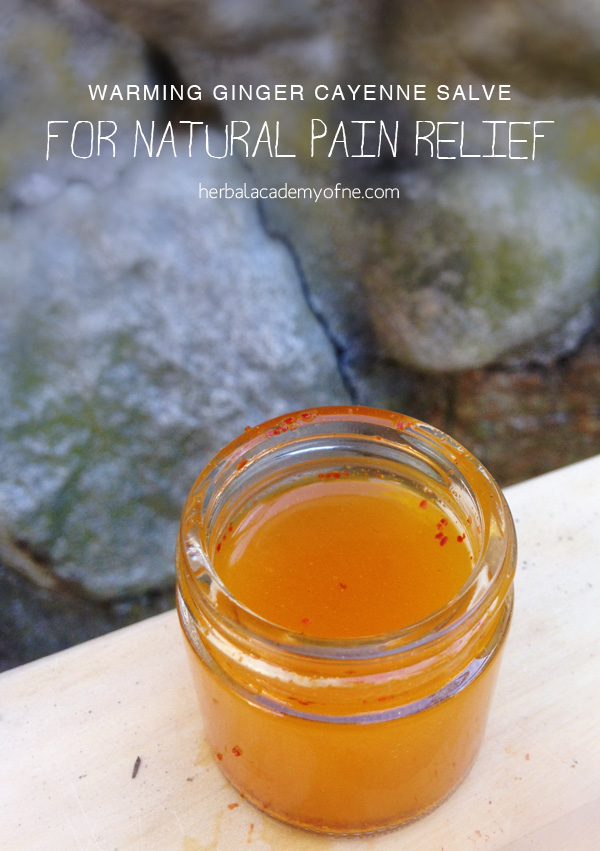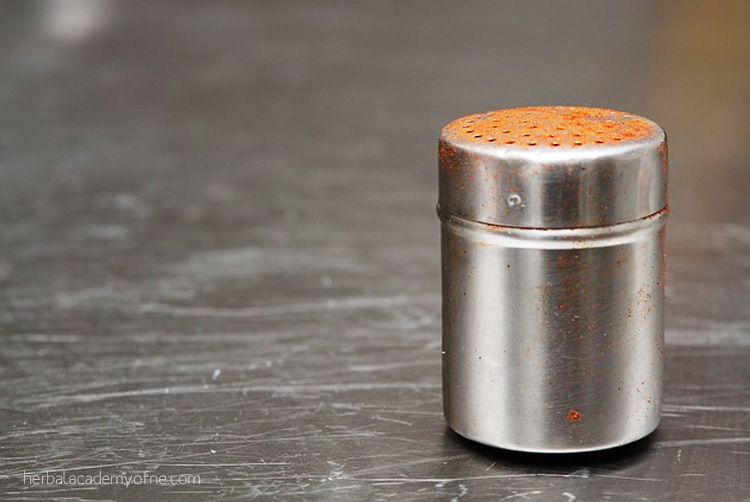
Warming Ginger Cayenne Salve For Natural Pain Relief
I have been going through surgeries on my spine since my first one, at 8 years old. It all started with scoliosis, and from there things got worse. It seemed that with every surgery, new symptoms and pain were added.
Over the last 20 years I have had 7 surgeries on my spine, causing paralysis from my knees down, and a good deal of back and nerve pain. Four years ago, I couldn’t take it anymore. I was tired of being prescribed so many pain pills with nothing but side effects, and decided to find healthier alternative methods that I could use to deal with the pain more effectively.
My pain-free quest started with yoga and meditation, which really made a drastic difference in my day-to-day abilities and level of pain, but I still needed something topically to help ease the pain on the days that it was harder to deal. After numerous attempts at finding something that worked for me, I finally created my very first warming ginger cayenne salve, and my life was changed forever. I had finally found something that is natural, doesn’t smell terrible (am I the only one who can’t stand the smell of Icy Hot?), and really worked to help ease my back and nerve pains.
Natural Pain Relief Using Herbs
On my journey to help soothe my poor, aching back, I began to learn that there are quite a few amazing herbs out there that can help ease both my back pain and neuropathy. Over a few years of trial and error, these have become my staple herbs when it comes to pain relief in the form of a topical salve:
Arnica – Native to the mountains, arnica flowers have been used in European folk medicine for centuries. Arnica is a well-known anti-inflammatory herb that really works miracles on sore muscles, sprains, and bruises by helping to improve the local blood supply and speed up healing. You can read more about this herb here.
Cayenne – The main ingredient in this salve, cayenne pepper, has a really ancient history dating as far back as 7,000 years ago. Naturally anti-inflammatory and antispasmodic, cayenne pepper contains a constituent called capsaicin. The reason that cayenne works so well for muscle and nerve pain is because the capsaicin blocks a neurotransmitter, called Substance P (SP), that transmits pain signals from the nerves to the central nervous system. When cayenne is used topically, it can help relieve all sorts of pain, from neuropathy, back pain, muscles spasms, menstrual cramps, and even arthritis.
Ginger root – Used for thousands of years in Traditional Chinese Medicine for all sorts of ailments including arthritis and muscle pain, ginger has undergone clinical studies for its anti-inflammatory abilities. The warming abilities of ginger help to improve circulation and relieve tension in tired muscles. Learn more about why we love ginger here.
Turmeric – One of the yummiest spices that gives curry its distinctive flavor and color, turmeric has numerous healing properties to it that not only help to ease muscle strain and pain, but also arthritis and joint inflammation. One of the constituents that give turmeric its superhero status, is curcumin, which naturally helps to lower the levels of enzymes within our body that cause inflammation. Read all about turmeric’s health benefits here.
Warming Ginger Cayenne Salve
This salve is great for all sorts of muscle aches, pains, arthritis, bruises, and even (my own arch nemesis) nerve pains! You can use essential oils in this salve, but it is already very effective without them. If you would like to add essential oils to this salve, ginger, black pepper, peppermint, eucalyptus, sweet marjoram, turmeric, lavender, and roman chamomile are staples in my own muscle salves (you can buy essential oils here)! Just be sure to research each of the essential oils you choose to add, and use them with safety in mind!
Warming Ginger Cayenne Salve
1 cup carrier oil (olive or coconut or even a combination of the two)
¼ cup beeswax pastilles
1 tablespoon cayenne pepper powder
1 tablespoon ginger root powder
1 tablespoon turmeric root powder
1 tablespoon arnica flowers (optional – I love to add arnica flowers to my salve)
- Using one of the oil infusion methods of your choice (like one of these), infuse cayenne, ginger, arnica, and turmeric in your carrier oil. My favorite method when we don’t have a lot of sunlight outside, is in a Mason jar in the oven over night.
- Once your oil is infused, using a cheesecloth, strain the herbs from the oil. Be sure to squeeze out every last bit of oil from the cheesecloth! You do not have to make a salve with this oil, if you do not want to. Keep this as a massage oil if you do not have the beeswax on hand. It even works well as a spot treatment, when you put this oil into a roll-on bottle.
- In a double boiler, combine beeswax and herbal infused oil. Remove from heat once the beeswax is melted, if you choose to add essential oils to this salve, this would be when you would add them to salve.
- Pour salve into jars or tins to cool and harden. Once totally cool, cover and store in a cool dark place when not in use.
To Use: Using a small dab (a little bit goes a long way!), massage into sore achy muscles and joints. If using for chronic pain such as arthritis, daily use is suggested and can take up to a week or two before you start seeing results.
Safety: Not for internal use. Do not use on open cuts or wounds. Not for use if pregnant or nursing. Keep out of the reach of children. Avoid use around face and other mucosal membranes because it will burn. Take extra care to wash hands thoroughly after use or use gloves when applying the salve.

This post was written by The Hippy Homemaker, Christina, who loves to share what she’s learning about green and eco-friendly living, natural health, aromatherapy, herbalism and more!
REFERENCES
Bode AM, Dong Z. The Amazing and Mighty Ginger. In: Benzie IFF, Wachtel-Galor S, editors. Herbal Medicine: Biomolecular and Clinical Aspects. 2nd edition. Boca Raton (FL): CRC Press; 2011. Chapter 7. Available from: http://www.ncbi.nlm.nih.gov/books/NBK92775/
Chevallier, Andrew. (2000). Encyclopedia of Herbal Medicine. London: DK Publishing. pp. 74
Gauri, MI. (2010). Local application of turmeric on delayed onset muscle soreness. Br J Sports Med;44:i45








